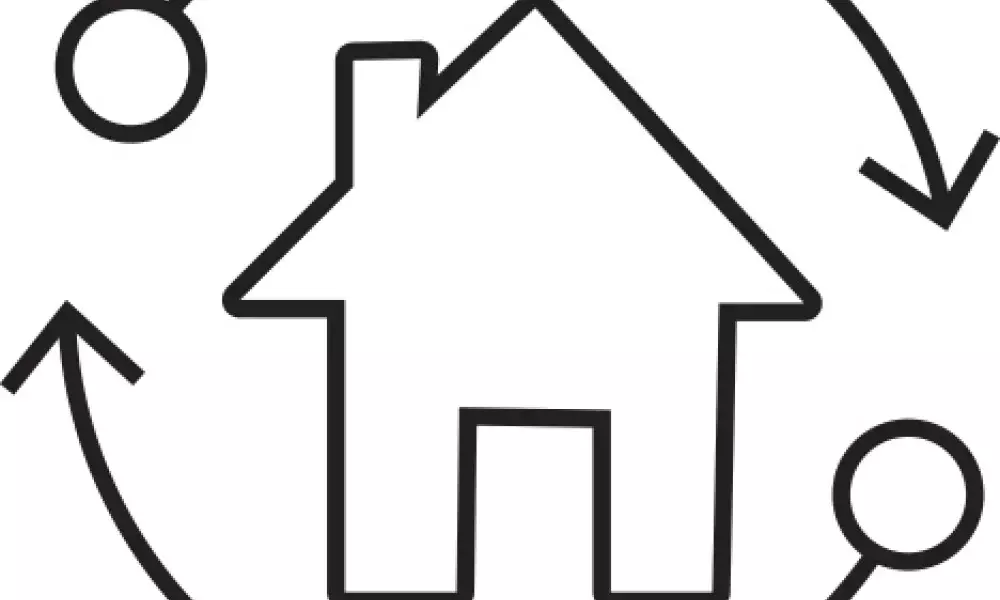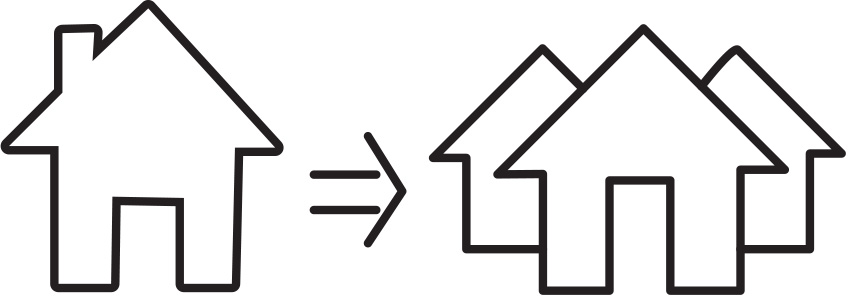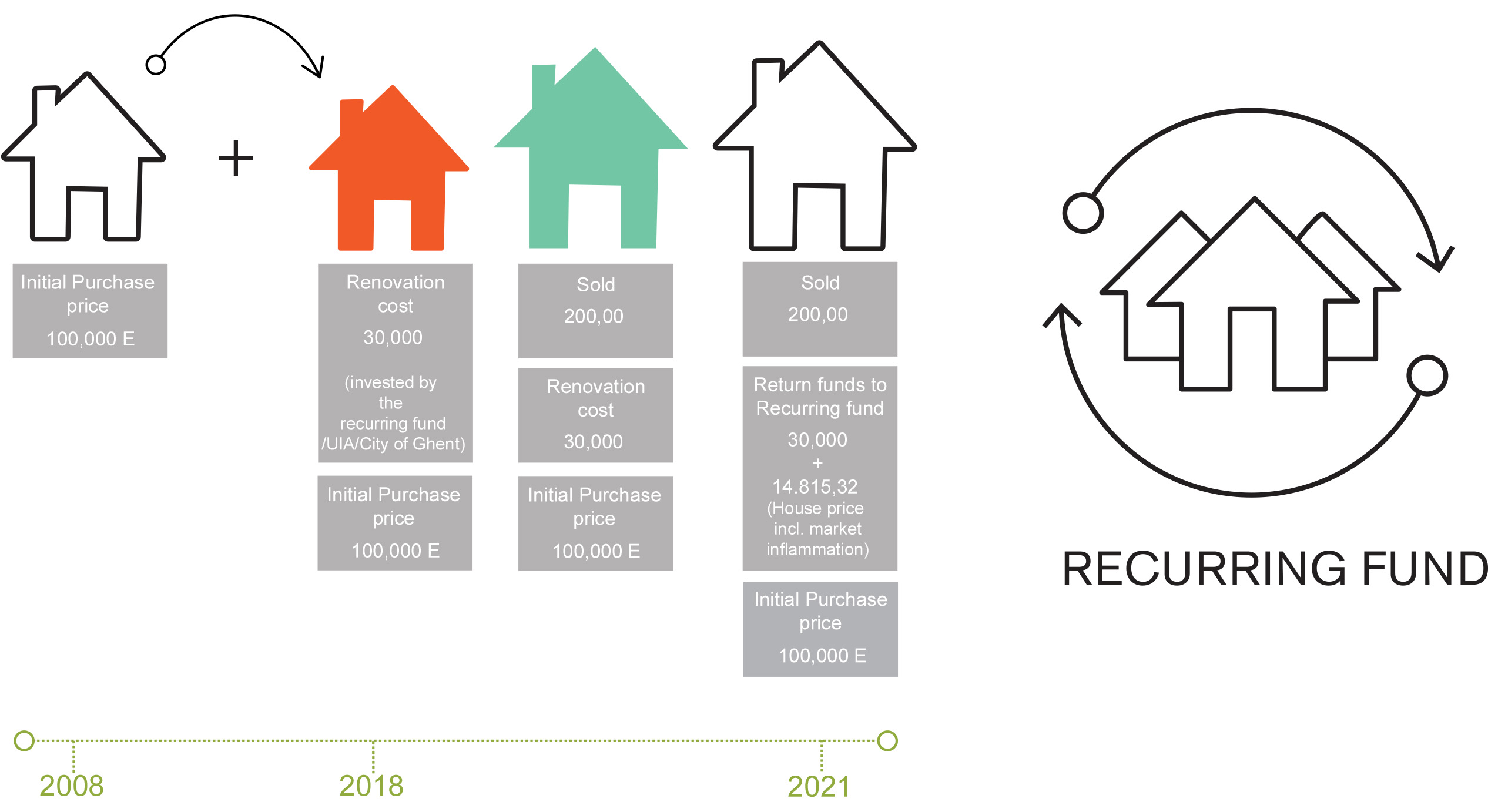'From House to Home' The Recurring Fund: A sustainable future for low-income housing renovations?

Ghent Knapt Op provides a unique housing renovation scheme for vulnerable citizens of Ghent. An innovative financial system, a 'recurring fund', is set up to make the renovations possible and to provide a financial sustainability for future renovations. The programme provides the social conditions and support for citizens to co-design and renovate their homes along side with the technical experts.
Ghent Knapt Op addresses the challenges by awarding 30,000 Euros per house for renovation works through a recurring fund to Captive residents. Captive residents get to take matters in their own hands and become active citizens by co-designing and preparing the renovation works. A team of experts support the participants in an integrated way (technically, juridical, socially and administrative) during the entire process. The financial intervention, which makes the renovation possible, will return to the fund if the building is alienated. This is guaranteed by taking a mortgage on the building.

In order to obtain the details and logistics of what a recurring fund is and how it operates, I interviewed the project manager of the Ghent Knap Op Derkien De Baets (City of Ghent) and Tom Verbeke, member of the research consortium KU Leuven, Brussels campus, and responsible of the Recurring fund research.

Accessing adequate affordable housing has undoubtedly become a pressing matter and challenge for all European countries. Especially in larger European cities the problem is most apparent with increasing housing rents and large urban populations living in substandard conditions or forced to moving to less expensive areas, which are in many instances far from their place of work and available services.
In particular Gent, a city of 260,000 inhabitants, Belgium, is like many cities: it lacks affordable and quality housing for its lower income citizens.
While 10% of Ghent’s housing stock is dedicated to social housing – significantly more than the regional average and comprised of a total of 14,347 social rental dwellings – it still remains too low to cover all citizens’ needs. Citizens on social housing waiting lists may wait 3 to 10 years for housing.
At the same time the loan charges are very low and home ownership is very common in Belgium (in 2013, 70,5% of the Flemish households were living in their own property), so it is quite common to buy a house instead of renting one on the private rental market or wait for a social housing. Gent Knapt Op, which means “Revitalizing Gent”, taps into that need of property owners, named 'captive residents', who have a low income and went through great lengths to buy a house but then did not have the means to renovate. Ghent has approximately 35,000 housing units in need of urgent upgrade.
1. How does the Recurring fund work?
The recurring fund is focused on home owners with limited or no resources to renovate their property. The fund (co-) finances (part of) the renovation and its aim is to improve the quality of the property so that it would meet the minimum standards included in the Flemish building code.
In addition, renovation aims to improve the property’s energy efficiency. The funds, currently with a maximum of €30.000, are made available as the renovation project is implemented. In addition, home-owners can benefit from advice and guidance at the design and implementation phase. Although various mechanisms exist that offer financial support to renovating home owners, without the participation of the fund it is highly unlikely that these projects, given the limited resources of the owners, would have been implemented. Subsidies and tax-related incentives often require that eligible activities have been completed and paid for before the paperwork for the subsidies of tax incentives can be completed. For the target group, these conditions essentially mean that they don’t have access to these support schemes, as they don’t have access to the funding required to complete and pay for the eligible activities. With the fund, they can access these schemes.
The fund is not a subsidy and it is not a loan. Unlike a subsidy, the contribution of the fund has to be repaid. Unlike loans, repaying the contribution does not require a fixed, monthly or yearly repayment. If the renovated house is sold, the value of the house is used to repay the fund’s nominal value. If the property’s value has risen over time, part of this capital gain is allocated to the revolving fund, more or less in line with the fund’s share of the house value after renovation works were completed. With these repayments, the revolving fund can contribute to new renovation projects.

2. What are the benefits of setting up a recurring fund?
The primary benefit is that it offers a way to finance renovation works of income-constrained home owners. As house prices have risen across the curve in almost all major cities, people on a low income often spend a major part of their income on housing costs. As a consequence, low income home owners have often little choice but to pay very high rents or to buy a property whose quality would not meet the standards in the Flemish building code. In addition, these properties often suffer from a lack of good insulation and don’t have efficient heating systems. The fund offers the group of low income home-owners a way to increase the quality of their property and in doing so the fund aims to contribute to the owner’s and his or her household’s health, quality of life and reduce their environmental footprint.
Second, in addition to funding, the guidance offered at the design and implementation stage unburdens these households. Having access to the right information on e.g. the existence of cost-efficient solutions to address quality issues and increase energy efficiency of their properties is a major benefit of the fund.
- What are the challenges?
To evaluate what the fund delivers in terms of improvements to the quality of life of the household and to the energy efficiency of the property, we need sufficient projects where renovation works have been completed. However, due to Covid, there has been some delay in many of these projects. In addition to the impact of renovation on the household’s quality of live and environmental footprint, completed projects are necessary to evaluate if and to what extent the terms of the fund are appropriate, for instance, if and to what extent the fund’s contribution (€30.000) is sufficient or if and to what extent the income-related conditions are appropriate for the target group.
- How can you make the fund sustainable?
When the property is sold, the fund’s nominal contribution returns to the fund. In addition, if there are capital gains, a percentage of those return to the fund as well. In the medium run, that should guarantee a constant flow of funds flowing back. These can then be used to fund new projects.
- What is the future of this recurring fund and what are your expectations?
In 2019, the building stock in the city of Ghent included 62.000 terraced or semi-detached houses. In terms of the average age, more than 60% of these were built before 1945 and one third occupied less than 65m². As a first approximation, it would be among owners of those houses where the fund would be able to contribute. Assuming that these are representative (in terms of size and age) for the house that presents the first quartile of the house price distribution – admittedly, a big assumption – their value in 2019 was €219.000. From the first data analysis, the average value of the property renovated was indeed €220.000. Since 2010, the value of the first quartile house has risen 61%. Given the characteristics of the housing stock and the price evolution of the first quartile house, the recurring fund will probably meet increased demand for funding.
How did the idea of the recurring fund come about?
In 2012, the problem of the captive owners was detected by the Community Land Trust initiative and they wrote a feasibility study about this, which came to the attention of the Public Center for Social Welfare.
At first, there was the idea of the community land trust team to purchase the land of the captive owners and put it in the trust, while the owners could stay and live in their house and renovate it with the profit of the sale of the land. However, studies showed that people were not inclined to participate in such a project. No-one wanted to sell the land underneath their house, because of the total value of the house. Then, they thought about another solution to support the captive owners in order to renovate their houses, which was the use of a recurring fund. The public center of social welfare provided an investment fund of 300.000 euro to test this idea with 10 houses of captive owners in the neighbourhood Dampoort.
What are the benefits of setting up a recurring fund?
Whenever a house is sold , the contribution of 30.000 euro plus a part of the capital gain is paid back to the recurrent fund. This contribution can then be used to renovate another house with the same process. This way, the recurrent fund of ICCARus makes sure that the public finances can be used over and over again.
What are the challenges?
First of all, it’s uncertain when the fund will start to ‘roll’. Secondly, we can’t foresee how much added value there will be created of time. We’re always sure that the 30.000 euro will return, but due to the inflation, 30.000 euro will be worth less in for example 2040, so there’s a risk that the fund will decline in value over time. Thirdly, there are also a lot of staff costs (social and technical guidance + coordination) connected to the 30.000 euro contribution, which has to be paid for each renovation process.
How can you make the fund sustainable?
There have to be injections in the fund in the next years, to get the fund really started. There are investment funds foreseen for the period of 2022-2026, enough to renovate 200 additional houses but the staff cost also has to be covered in order to make the fund sustainable. This is also the case for the period 2021-2026. To make the fund sustainable, there will always have to be someone monitoring the fund, and there will be additional staff costs, whenever a new renovation wave will be set up.
About this resource
The Urban Innovative Actions (UIA) is a European Union initiative that provided funding to urban areas across Europe to test new and unproven solutions to urban challenges. The initiative had a total ERDF budget of €372 million for 2014-2020.
Similar content




